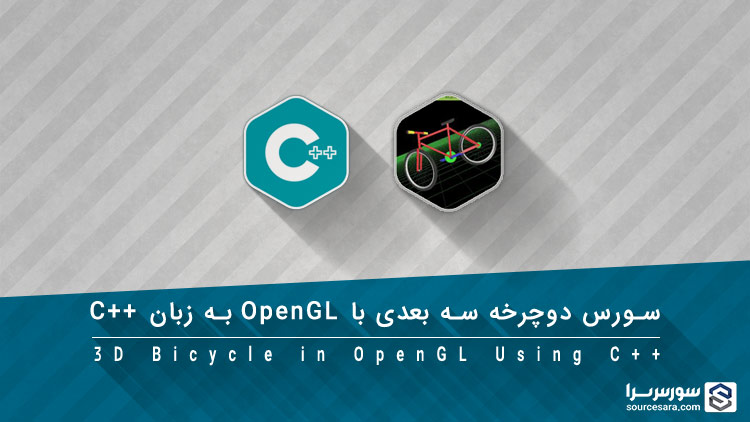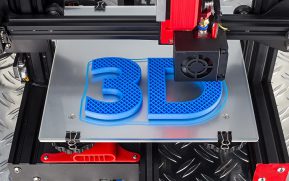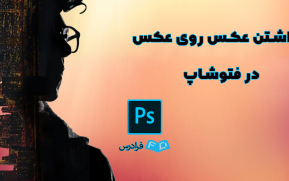

سورس دوچرخه سه بعدی با OpenGL به زبان C++
در این بخش سورس شبیه سازی هواپیمای کوچک با OpenGL را برای شما آماده کرده ایم که با استفاده از زبان برنامه نویسی C++ نوشته شده است. سورس کد این پروژه برای یاد گیری چگونگی ساخت بازی های ساده و کوچک با OpenGL مناسب است و می توانید با مشاهده آن مواردی همچون حرکت دوربین، رسم اشکال مختلف، حرکت دادن شیء ها، گرید بندی را بیاموزید. در ادامه می توانید توضیحات و تصاویر مربوط به این برنامه را مشاهده کنید.
توضیحات پروژه
در این پروژه OpenGL، بعد از اجرا شدن برنامه، یک دوچرخه سه بعدی در صفحه گریدبندی شده رسم می شود و با اسفاده از ماوس می توان دوربین را جهت های مختلف حرکت داد. همچنین امکان به حرکت درآوردن دوچرخه با استفاده از کلید + و متوقف کردن آن با کلید – وجود دارد.
در زیر برخی از توابع استفاده شده در این پروژه را مشاهده می کنید:
- تابع motion: برای حرکت دادن دوچرخه استفاده می شود.
- تابع drawTyre: برای ترسیم چرخ های دوچرخه استفاده می شود.
- تابع drawPedals: برای رسم پدال دوچرخه استفاده می شود.
- تابع drawChain: برای رسم زنجیر دوچرخه استفاده می شود.
- تابع seat: برای ترسیم صندلی دوچرخه استفاده می شود.

قسمت های از سورس پروژه:
#include <gl\glut.h>
#include <stdio.h>
#include <math.h>
#define PI 3.14159
#define WIN_WIDTH 600
#define WIN_HEIGHT 500
#define CYCLE_LENGTH 3.3f
#define ROD_RADIUS 0.05f
#define NUM_SPOKES 20
#define SPOKE_ANGLE 18
#define RADIUS_WHEEL 1.0f
#define TUBE_WIDTH 0.08f
#define RIGHT_ROD 1.6f
#define RIGHT_ANGLE 48.0f
#define MIDDLE_ROD 1.7f
#define MIDDLE_ANGLE 106.0f
#define BACK_CONNECTOR 0.5f
#define LEFT_ANGLE 50.0f
#define WHEEL_OFFSET 0.11f
#define WHEEL_LEN 1.1f
#define TOP_LEN 1.5f
#define CRANK_ROD 0.7f
#define CRANK_RODS 1.12f
#define CRANK_ANGLE 8.0f
#define HANDLE_ROD 1.2f
#define FRONT_INCLINE 70.0f
#define HANDLE_LIMIT 70.0f
#define INC_STEERING 2.0f
#define INC_SPEED 0.05f
/*****************************************
* All the Global Variables are Here
****************************************/
/*****************************************
* Cycle - related variables
******************************************/
GLfloat pedalAngle, speed, steering;
/*******************************
* User view realted variables
********************************/
GLfloat camx, camy, camz;
GLfloat anglex, angley, anglez;
/****************************
* Mouse related variables
****************************/
int prevx, prevy;
GLenum Mouse;
/**************************
* Cycle position related
* variables
***************************/
GLfloat xpos, zpos, direction;
void ZCylinder(GLfloat radius, GLfloat length);
void XCylinder(GLfloat radius, GLfloat length);
void drawFrame(void);
void gear(GLfloat inner_radius, GLfloat outer_radius,
GLfloat width, GLint teeth, GLfloat tooth_depth);
void drawChain(void);
void drawPedals(void);
void drawTyre(void);
void drawSeat(void);
void help(void);
void init(void);
void reset(void);
void display(void);
void idle(void);
void updateScene(void);
void landmarks(void);
void special(int key, int x, int y);
void keyboard(unsigned char key, int x, int y);
void mouse(int button, int state, int x, int y);
void motion(int x, int y);
void reshape(int w, int h);
void glSetupFuncs(void);
GLfloat Abs(GLfloat);
GLfloat degrees(GLfloat);
GLfloat radians(GLfloat);
GLfloat angleSum(GLfloat, GLfloat);
/*************************************
* End of the header file
*************************************/
/**************************************
* Start of the source file "cycle.c"
**************************************/
//#include "cycle.h"
/******************************************
* A
* 1 ========== 2
* /\ | B
* / \ / 5
* E / \D /
* / \ / C
* / \ /
* 3 ==========/ 4
* F
* 1 = 212,82
* 2 = 368,82
* 5 = 369,94
* 3 = 112,220
* 4 = 249,232
*
* 214 = 73
* 124 = 55
* 142 = 52
* 143 = 73
* 134 = 50
* 431 = 57
****************************************/
void ZCylinder(GLfloat radius, GLfloat length)
{
GLUquadricObj *cylinder;
cylinder = gluNewQuadric();
glPushMatrix();
glTranslatef(0.0f, 0.0f, 0.0f);
gluCylinder(cylinder, radius, radius, length, 15, 5);
glPopMatrix();
}
void XCylinder(GLfloat radius, GLfloat length)
{
glPushMatrix();
glRotatef(90.0f, 0.0f, 1.0f, 0.0f);
ZCylinder(radius, length);
glPopMatrix();
}
// called by idle()
void updateScene()
{
GLfloat xDelta, zDelta;
GLfloat rotation;
GLfloat sin_steering, cos_steering;
// if the tricycle is not moving then do nothing
if (-INC_SPEED < speed && speed < INC_SPEED) return;
if (speed < 0.0f)
pedalAngle = speed = 0.0f;
// otherwise, calculate the new position of the tricycle
// and the amount that each wheel has rotated.
// The tricycle has moved "speed*(time elapsed)".
// We assume that "(time elapsed)=1".
xDelta = speed*cos(radians(direction + steering));
zDelta = speed*sin(radians(direction + steering));
xpos += xDelta;
zpos -= zDelta;
pedalAngle = degrees(angleSum(radians(pedalAngle), speed / RADIUS_WHEEL));
// we'll be using sin(steering) and cos(steering) more than once
// so calculate the values one time for efficiency
sin_steering = sin(radians(steering));
cos_steering = cos(radians(steering));
// see the assignment 3 "Hint"
rotation = atan2(speed * sin_steering, CYCLE_LENGTH + speed * cos_steering);
direction = degrees(angleSum(radians(direction), rotation));
}
/*****************************
* Reset The scene
*****************************/
void reset()
{
anglex = angley = anglez = 0.0f;
pedalAngle = steering = 0.0f;
Mouse = GLUT_UP;
pedalAngle = speed = steering = 0.0f;
camx = camy = 0.0f;
camz = 5.0f;
xpos = zpos = 0.0f;
direction = 0.0f;
}
int main(int argc, char *argv[])
{
help();
glutInit(&argc, argv);
glutInitDisplayMode(GLUT_DOUBLE | GLUT_RGB);
glutInitWindowPosition(300, 100);
glutInitWindowSize(WIN_WIDTH, WIN_HEIGHT);
glutCreateWindow("SourceSara.Com | 3D Bicycle");
init();
glSetupFuncs();
glutMainLoop();
}
نکات
- این پروژه در نرم افزار Visual Studio نسخه ۲۰۱۵ تست شده است و به خوبی کار می کند.
- به منظور اجرای پروژه های OpenGL باید آن را بر روی IDE خود نصب کنید (آموزش نصب OpenGL).
- در صورت نا مفهوم بودن بخشی از کد، می توانید در قسمت نظرات مطرح کنید تا برای شما توضیح داده شود.
نوشته سورس دوچرخه سه بعدی با OpenGL به زبان C++ اولین بار در سورس سرا - آموزش برنامه نویسی. پدیدار شد.





